Emission Inventories and Particulate Matter Air Quality Modeling over the Pearl River Delta Region
Abstract
1. Introduction
2. Modeling Setup and Configuration
3. The Atmospheric Emission Inventories
3.1. Temporal and Spatial Disaggregation
3.2. Total and Spatial Distribution Results
4. WRF-CAMx System Emissions Comparative Performance
5. Conclusions
Author Contributions
Funding
Institutional Review Board Statement
Informed Consent Statement
Conflicts of Interest
References
- WHO (World Health Organization). Ambient (Outdoor) Air Quality and Health. Available online: http://www.who.int (accessed on 31 January 2021).
- Costa, S.; Ferreira, J.; Silveira, C.; Costa, C.; Lopes, D.; Relvas, H.; Borrego, C.; Roebeling, P.; Miranda, A.I.; Paulo Teixeira, J. Integrating Health on Air Quality Assessment—Review Report on Health Risks of Two Major European Outdoor Air Pollutants: PM and NO2. J. Toxicol. Environ. Health Part B Crit. Rev. 2014, 17, 307–340. [Google Scholar] [CrossRef]
- WHO (World Health Organization). Health Effects of Particulate Matter: Policy Implications for Countries in Eastern Europe, Caucasus and Central Asia; World Health Organization Regional Office for Europe: Copenhagen, Denmark, 2013; Volume 50. [Google Scholar]
- Bie, J.; De Jong, M.; Derudder, B. Greater Pearl River Delta: Historical Evolution towards a Global City-Region. J. Urban Technol. 2015, 22, 103–123. [Google Scholar] [CrossRef]
- Huang, H.; Ho, K.F.; Lee, S.C.; Tsang, P.K.; Ho, S.S.H.; Zou, C.W.; Zou, S.C.; Cao, J.J.; Xu, H.M. Characteristics of carbonaceous aerosol in PM2.5: Pearl Delta River Region, China. Atmos. Res. 2012, 104–105, 227–236. [Google Scholar] [CrossRef]
- Zhao, S.X.B.; Zhang, L. Foreign Direct Investment and the Formation of Global City-Regions in China. Reg. Stud. 2007, 41, 979–994. [Google Scholar] [CrossRef]
- Florida, R.; Gulden, T.; Mellander, C. The rise of the mega-region. Camb. J. Reg. Econ. Soc. 2008, 1, 459–476. [Google Scholar] [CrossRef]
- Chen, J.; Xin, J.; An, J.; Wang, Y.; Liu, Z.; Chao, N.; Meng, Z. Observation of aerosol optical properties and particulate pollution at background station in the Pearl River Delta region. Atmos. Res. 2014, 143, 216–227. [Google Scholar] [CrossRef]
- Hoi, K.I.; Mok, K.M.; Yuen, K.V.; Pun, M.H. Investigation of fine particulate pollution in a coastal city with a mobile monitoring platform. Glob. NEST J. 2013, 15, 178–187. [Google Scholar] [CrossRef]
- Lopes, D.; Hoi, K.I.; Mok, K.M.; Miranda, A.I.; Yuen, K.V.; Borrego, C. Air quality in the main cities of the Pearl River Delta region. Glob. Nest J. 2016, 18, 794–802. [Google Scholar] [CrossRef]
- Mok, K.M.; Hoi, K.I. Effects of meteorological conditions on PM10 concentrations—A study in Macau. Environ. Monit. Assess. 2005, 102, 201–223. [Google Scholar] [CrossRef] [PubMed]
- CAA (Clean Air Asia). Air Pollution Prevention and Control Progress in Chinese Cities; CAA: Beijing, China, 2016. [Google Scholar]
- Ferreira, J.; Lopes, D.; Rafael, S.; Relvas, H.; Almeida, S.M.; Miranda, A.I. Modelling air quality levels of regulated metals: Limitations and challenges. Environ. Sci. Pollut. Res. 2020, 27, 33916–33928. [Google Scholar] [CrossRef]
- EC-JRC/PBL. Emission Database for Global Atmospheric Research Version 4.2. Available online: https://data.jrc.ec.europa.eu/collection/edgar (accessed on 1 October 2015).
- MEIC (Multi-Resolution Emission Inventory for China). Available online: http://www.meicmodel.org (accessed on 12 June 2017).
- Kurokawa, J.; Ohara, T.; Morikawa, T.; Hanayama, S.; Janssens-Maenhout, G.; Fukui, T.; Kawashima, K.; Akimoto, H. Emissions of air pollutants and greenhouse gases over Asian regions during 2000-2008: Regional Emission inventory in ASia (REAS) version 2. Atmos. Chem. Phys. 2013, 13, 11019–11058. [Google Scholar] [CrossRef]
- Hung, X.; Song, Y.; Li, M.; Li, J.; Huo, Q.; Cai, X.; Zhu, T.; Hu, M.; Zhang, H. A high-resolution ammonia emission inventory in China. Glob. Biogeochem. Cycles 2012, 26. [Google Scholar] [CrossRef]
- Lu, Z.; Zhang, Q.; Streets, D.G. Sulfur dioxide and primary carbonaceous aerosol emissions in China and India, 1996–2010. Atmos. Chem. Phys. 2011, 11, 9839–9864. [Google Scholar] [CrossRef]
- Lu, Z.; Streets, D.G. Increase in NOx emissions from indian thermal power plants during 1996–2010: Unit-based inventories and multisatellite observations. Environ. Sci. Technol. 2012, 46, 7463–7470. [Google Scholar] [CrossRef] [PubMed]
- Lee, D.-G.; Lee, Y.-M.; Jang, K.; Yoo, C.; Kang, K.; Lee, J.-H.; Jung, S.; Park, J.; Lee, S.-B.; Han, J.; et al. Korean National Emissions Inventory System and 2007 Air Pollutant Emissions. Asian J. Atmos. Environ. 2011, 5, 278–291. [Google Scholar] [CrossRef]
- Li, M.; Zhang, Q.; Kurokawa, J.I.; Woo, J.H.; He, K.; Lu, Z.; Ohara, T.; Song, Y.; Streets, D.G.; Carmichael, G.R.; et al. MIX: A mosaic Asian anthropogenic emission inventory under the international collaboration framework of the MICS-Asia and HTAP. Atmos. Chem. Phys. 2017, 17, 935–963. [Google Scholar] [CrossRef]
- Skamarock, W.C.; Klemp, J.B.; Dudhi, J.; Gill, D.O.; Barker, D.M.; Duda, M.G.; Huang, X.-Y.; Wang, W.; Powers, J.G. A Description of the Advanced Research WRF Version 3; University Corporation for Atmospheric Research (UCAR): Boulder, CO, USA, 2008. [Google Scholar]
- ENVIRON. CAMx User’s Guide Version 6.2 User’s Guide Comprehensive Air Quality Model; ENVIRON International Corporation: Emeryville, CA, USA, 2015. [Google Scholar]
- Pepe, N.; Pirovano, G.; Balzarini, A.; Toppetti, A.; Riva, G.M.; Amato, F.; Lonati, G. Enhanced CAMx source apportionment analysis at an urban receptor in Milan based on source categories and emission regions. Atmos. Environ. X 2019, 2, 100020. [Google Scholar] [CrossRef]
- Ferreira, J.; Rodriguez, A.; Monteiro, A.; Miranda, A.I.; Dios, M.; Souto, J.A.; Yarwood, G.; Nopmongcol, U.; Borrego, C. Air quality simulations for North America—MM5-CAMx modelling performance for main gaseous pollutants. Atmos. Environ. 2012, 53, 212–224. [Google Scholar] [CrossRef]
- Chen, Y.; Fung, J.C.H.; Chen, D.; Shen, J.; Lu, X. Chemosphere Source and exposure apportionments of ambient PM2.5 under different synoptic patterns in the Pearl River Delta region. Chemosphere 2019, 236, 124266. [Google Scholar] [CrossRef]
- Lopes, D.; Ferreira, J.; Hoi, K.I.; Miranda, A.I.; Yuen, K.V.; Mok, K.M. Weather research and forecasting model simulations over the Pearl River Delta Region. Air Qual. Atmos. Health 2019, 12, 115–125. [Google Scholar] [CrossRef]
- Hong, S.; Lim, J. The WRF single-moment 6-class microphysics scheme (WSM6). J. Korean Meteorol. Soc. 2006, 42, 129–151. [Google Scholar]
- Mlawer, E.J.; Taubman, S.J.; Brown, P.D.; Iacono, M.J.; Clough, S.A. Radiative transfer for inhomogeneous atmospheres: RRTM, a validated correlated-k model for the longwave. J. Geophys. Res. 1997, 102, 16663. [Google Scholar] [CrossRef]
- Dudhia, J. Numerical Study of Convection Observed during the Winter Monsoon Experiment Using a Mesoscale Two-Dimensional Model. J. Atmos. Sci. 1989, 46, 3077–3107. [Google Scholar] [CrossRef]
- Paulson, C.A. The Mathematical Representation of Wind Speed and Temperature Profiles in the Unstable Atmospheric Surface Layer. J. Appl. Meteorol. 1970, 9, 857–861. [Google Scholar] [CrossRef]
- Dyer, A.J.; Hicks, B.B. Flux-gradient relationships in the constant flux layer. Q. J. R. Meteorol. Soc. 1970, 96, 715–721. [Google Scholar] [CrossRef]
- Webb, E.K. Profile relationships: The log-linear range, and extension to strong stability. Q. J. R. Meteorol. Soc. 1970, 96, 67–90. [Google Scholar] [CrossRef]
- Chen, F.; Dudhia, J. Coupling an Advanced Land Surface–Hydrology Model with the Penn State–NCAR MM5 Modeling System. Part I: Model Implementation and Sensitivity. Mon. Weather Rev. 2001, 129, 587–604. [Google Scholar] [CrossRef]
- Kain, J.S. The Kain–Fritsch Convective Parameterization: An Update. J. Appl. Meteorol. 2004, 43, 170–181. [Google Scholar] [CrossRef]
- Hong, S.-Y.; Noh, Y.; Dudhia, J. A New Vertical Diffusion Package with an Explicit Treatment of Entrainment Processes. Mon. Weather Rev. 2006, 134, 2318–2341. [Google Scholar] [CrossRef]
- Emery, C.; Tai, E.; Yarwood, G.; Morris, R. Investigation into approaches to reduce excessive vertical transport over complex terrain in a regional photochemical grid model. Atmos. Environ. 2011, 45, 7341–7351. [Google Scholar] [CrossRef]
- NCAR. Model for Ozone and Related chemical Tracers, Version 4 (MOZART-4). Available online: https://www.acom.ucar.edu/wrf-chem/mozart.shtml (accessed on 20 November 2015).
- NASA. Total Ozone Mapping Spectrometer (TOMS) Data. Available online: ftp://toms.gsfc.nasa.gov/pub/omi/data/ (accessed on 20 November 2015).
- Wang, X.; Mauzerall, D.L.; Hu, Y.; Russell, A.G.; Larson, E.D.; Woo, J.H.; Streets, D.G.; Guenther, A. A high-resolution emission inventory for eastern China in 2000 and three scenarios for 2020. Atmos. Environ. 2005, 39, 5917–5933. [Google Scholar] [CrossRef][Green Version]
- SMG Direcção dos Serviços Meteorológicos e Geofísicos. Available online: http://www.smg.gov.mo (accessed on 6 December 2017).
- HKEPD (Hong Kong Environmental Protection Department). Available online: https://www.epd.gov.hk (accessed on 6 December 2017).
- Li, X.; Lopes, D.; Mok, K.M.; Miranda, A.I.; Yuen, K.V. Development of a road traffic emission inventory with high spatial–temporal resolution in the world’s most densely populated region—Macau. Environ. Monit. Assess. 2019, 191–239. [Google Scholar] [CrossRef] [PubMed]
- Zhang, S.; Wu, Y.; Huang, R.; Wang, J.; Yan, H.; Zheng, Y.; Hao, J. High-resolution simulation of link-level vehicle emissions and concentrations for air pollutants in a traffic-populated eastern Asian city. Atmos. Chem. Phys. 2016, 16, 9965–9981. [Google Scholar] [CrossRef]
- van der Gon, H.D.; Hendriks, C.; Kuenen, J.; Segers, A.; Visschedijk, A. TNO Report Description of Current Temporal Emission Patterns and Sensitivity of Predicted AQ for Temporal Emission Patterns; TNO: Utrecht, The Netherlands, 2011. [Google Scholar]
- USGSLCI (The United States Geological Survey Land Cover Institute). 0.5 km MODIS-Based Global Land Cover Climatology. Available online: https://www.usgs.gov/ (accessed on 2 October 2015).
- Fu, J.; Jiang, D.; Huang, Y. 1 km grid GDP data of China (2005, 2010). Acta Geogr. Sin. 2014, 69, 140–143. [Google Scholar] [CrossRef]
- CSD (Census and Statistics Department). Hong Kong Census Data. Available online: https://www.censtatd.gov.hk (accessed on 1 November 2017).
- DSEC (Direcção dos Serviços de Estatística e Censos). Macau Census. Available online: https://www.dsec.gov.mo (accessed on 1 November 2017).
- PSA. Philippines Census Data. Available online: https://psa.gov.ph/statistics/census/population-and-housing/2010-CPH (accessed on 2 October 2015).
- NSRC. Taiwan Census Data. Available online: http://ebas1.ebas.gov.tw/phc2010/english/rehome.htm (accessed on 2 October 2015).
- Schneider, A.; Mertes, C.M.; Tatem, A.J.; Tan, B.; Sulla-Menashe, D.; Graves, S.J.; Patel, N.N.; Horton, J.A.; Gaughan, A.E.; Rollo, J.T.; et al. A new urban landscape in East–Southeast Asia, 2000–2010. Environ. Res. Lett. 2015, 10. [Google Scholar] [CrossRef]
- Schneider, A.; Mertes, C. Expansion and growth in Chinese cities, 1978–2010. Environ. Res. Lett. 2014, 9. [Google Scholar] [CrossRef]
- ESCAP (Economic and Social Commission for Asia and the Pacific). The State of Asian and Pacific Cities 2015. Urban Transformations. Shifting from Quantity to Quality; UN-Habitat: Bangkok, Thailand, 2015. [Google Scholar]
- Li, H.; Chen, K.S.; Lai, C.H.; Wang, H. Measurements of Gaseous Pollutant Concentrations in the Hsuehshan Traffic Tunnel of Northern Taiwan. Aerosol Air Qual. Res. 2011, 11, 776–782. [Google Scholar] [CrossRef]
- Cai, H.; Xie, S.D. Tempo-spatial variation of emission inventories of speciated volatile organic compounds from on-road vehicles in China. Atmos. Chem. Phys. Discuss. 2009, 9, 11051–11085. [Google Scholar] [CrossRef]
- Dai, S.; Bi, X.; Chan, L.Y.; He, J.; Wang, B.; Wang, X.; Peng, P.; Sheng, G.; Fu, J. Chemical and stable carbon isotopic composition of PM2.5 from on-road vehicle emissions in the PRD region and implications for vehicle emission control policy. Atmos. Chem. Phys. 2015, 15, 3097–3108. [Google Scholar] [CrossRef]
- He, L.Y.; Hu, M.; Huang, X.F.; De Yu, B.; Zhang, Y.H.; Liu, D.Q. Measurement of emissions of fine particulate organic matter from Chinese cooking. Atmos. Environ. 2004, 38, 6557–6564. [Google Scholar] [CrossRef]
- Yuan, B.; Shao, M.; Lu, S.; Wang, B. Source profiles of volatile organic compounds associated with solvent use in Beijing, China. Atmos. Environ. 2010, 44, 1919–1926. [Google Scholar] [CrossRef]
- EPA (Environmental Protection Agency). SPECIATE 4.4 Database. Available online: https://www.epa.gov/ (accessed on 1 June 2015).
- Zheng, H.; Zhao, B.; Wang, S.; Wang, T.; Ding, D.; Chang, X.; Liu, K.; Xing, J.; Dong, Z.; Aunan, K.; et al. Transition in source contributions of PM2.5 exposure and associated premature mortality in China during 2005–2015. Environ. Int. 2019, 132. [Google Scholar] [CrossRef]
- Heinke, K.; Sokhi, R.S. Overview of Tools and Methods for Meteorological and Air Pollution Mesoscale Model Evaluation and User Training. Join Report of COST Action 728; World Meteorological Organization (WMO): Geneva, Switzerland, 2008; Volume 41, pp. 25–26. [Google Scholar]
- Borrego, C.; Monteiro, A.; Ferreira, J.; Miranda, A.I.; Costa, A.M.; Carvalho, A.C.; Lopes, M. Procedures for estimation of modelling uncertainty in air quality assessment. Environ. Int. 2008, 34, 613–620. [Google Scholar] [CrossRef] [PubMed]
- Chen, X.-L.; Feng, Y.-R.; Li, J.-N.; Lin, W.-S.; Fan, S.-J.; Wang, A.-Y.; Fong, S.; Lin, H. Numerical Simulations on the Effect of Sea-Land Breezes on Atmospheric Haze over the Pearl River Delta Region. Environ. Model. Assess. 2007, 14, 351–363. [Google Scholar] [CrossRef]
- Qin, M.; Wang, X.; Hu, Y.; Huang, X.; He, L.; Zhong, L.; Song, Y.; Hu, M.; Zhang, Y. Formation of particulate sulfate and nitrate over the Pearl River Delta in the fall: Diagnostic analysis using the Community Multiscale Air Quality model. Atmos. Environ. 2015, 112, 81–89. [Google Scholar] [CrossRef]
- Kwok, R.H.F.; Fung, J.C.H.; Lau, A.K.H.; Fu, J.S. Numerical study on seasonal variations of gaseous pollutants and particulate matters in Hong Kong and Pearl River Delta Region. J. Geophys. Res. 2010, 115, D16308. [Google Scholar] [CrossRef]
- Fan, Q.; Lan, J.; Liu, Y.; Wang, X.; Chan, P.; Hong, Y.; Feng, Y.; Liu, Y.; Zeng, Y.; Liang, G. Process analysis of regional aerosol pollution during spring in the Pearl River Delta region, China. Atmos. Environ. 2015, 122, 829–838. [Google Scholar] [CrossRef]
- Liu, Y.; Hong, Y.; Fan, Q.; Wang, X.; Chan, P.; Chen, X.; Lai, A.; Wang, M.; Chen, X. Source-receptor relationships for PM2.5 during typical pollution episodes in the Pearl River Delta city cluster, China. Sci. Total Environ. 2017, 596–597, 194–206. [Google Scholar] [CrossRef]
- Wang, N.; Lyu, X.P.; Deng, X.J.; Guo, H.; Deng, T.; Li, Y.; Yin, C.Q.; Li, F.; Wang, S.Q. Assessment of regional air quality resulting from emission control in the Pearl River Delta region, southern China. Sci. Total Environ. 2016, 573, 1554–1565. [Google Scholar] [CrossRef]
- Yan, J.; Chen, L.; Lin, Q.; Zhao, S.; Zhang, M. Effect of typhoon on atmospheric aerosol particle pollutants accumulation over Xiamen, China. Chemosphere 2016, 159, 244–255. [Google Scholar] [CrossRef] [PubMed]
- Fang, G.C.; Lin, S.J.; Chang, S.Y.; Chou, C.C.K. Effect of typhoon on atmospheric particulates in autumn in central Taiwan. Atmos. Environ. 2009, 43, 6039–6048. [Google Scholar] [CrossRef]
- Liu, W.; Han, Y.; Yin, Y.; Duan, J.; Gong, J.; Liu, Z.; Xu, W. An aerosol air pollution episode affected by binary typhoons in east and central China. Atmos. Pollut. Res. 2018, 9, 634–642. [Google Scholar] [CrossRef]
- Wu, D.; Tie, X.; Li, C.; Ying, Z.; Lau, A.K.H.; Huang, J.; Deng, X.; Bi, X. An extremely low visibility event over the Guangzhou region: A case study. Atmos. Environ. 2005, 39, 6568–6577. [Google Scholar] [CrossRef]
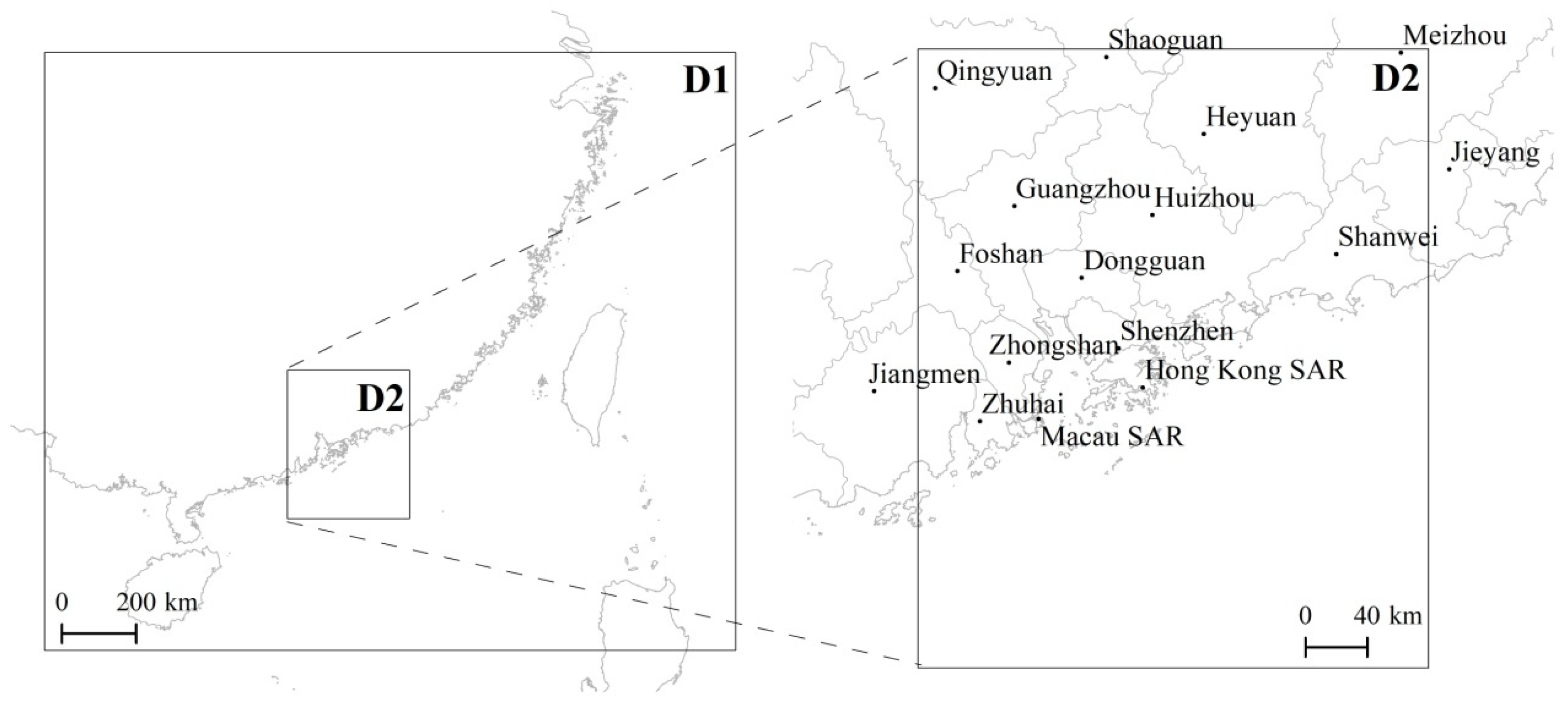


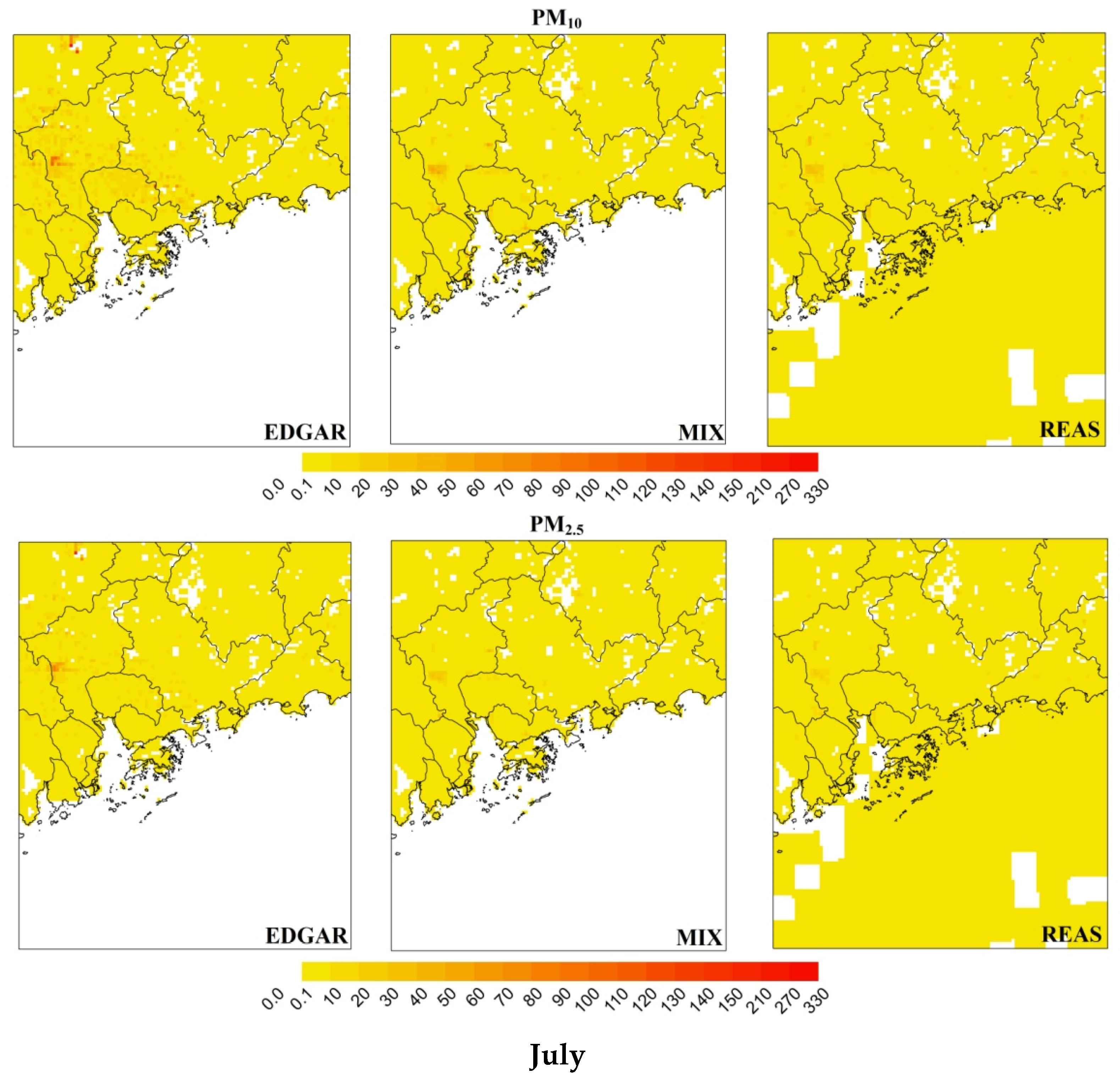
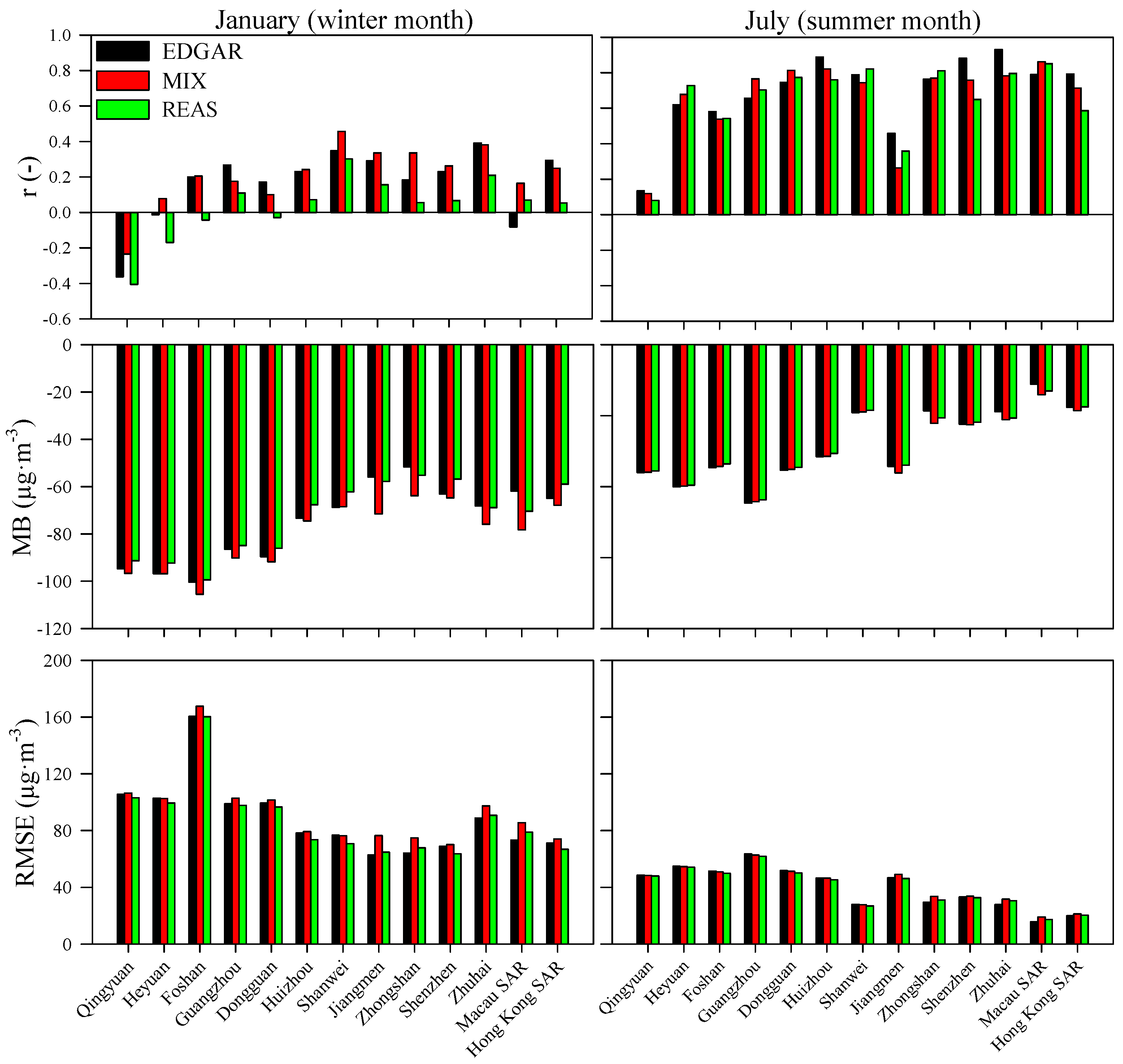
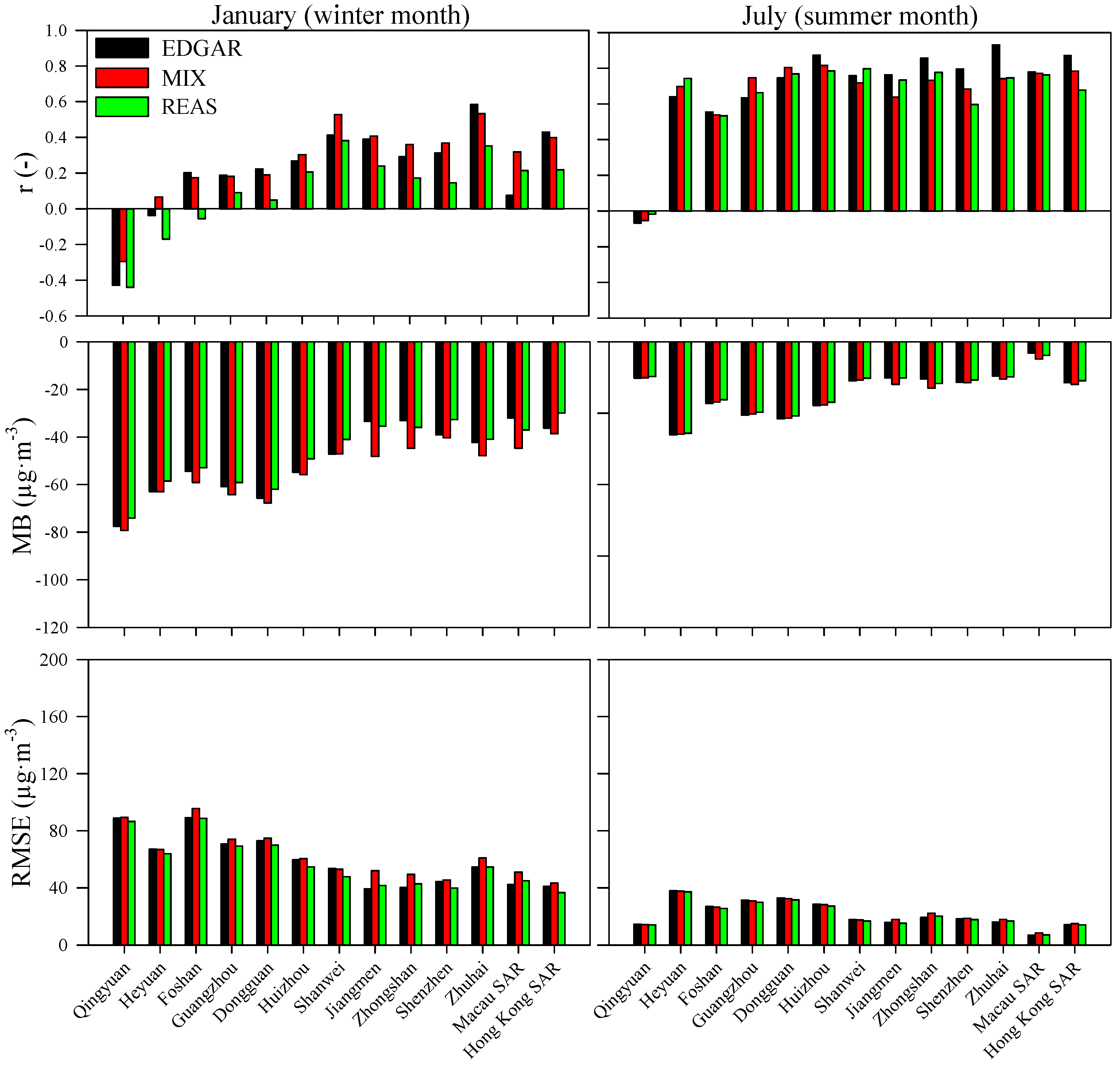
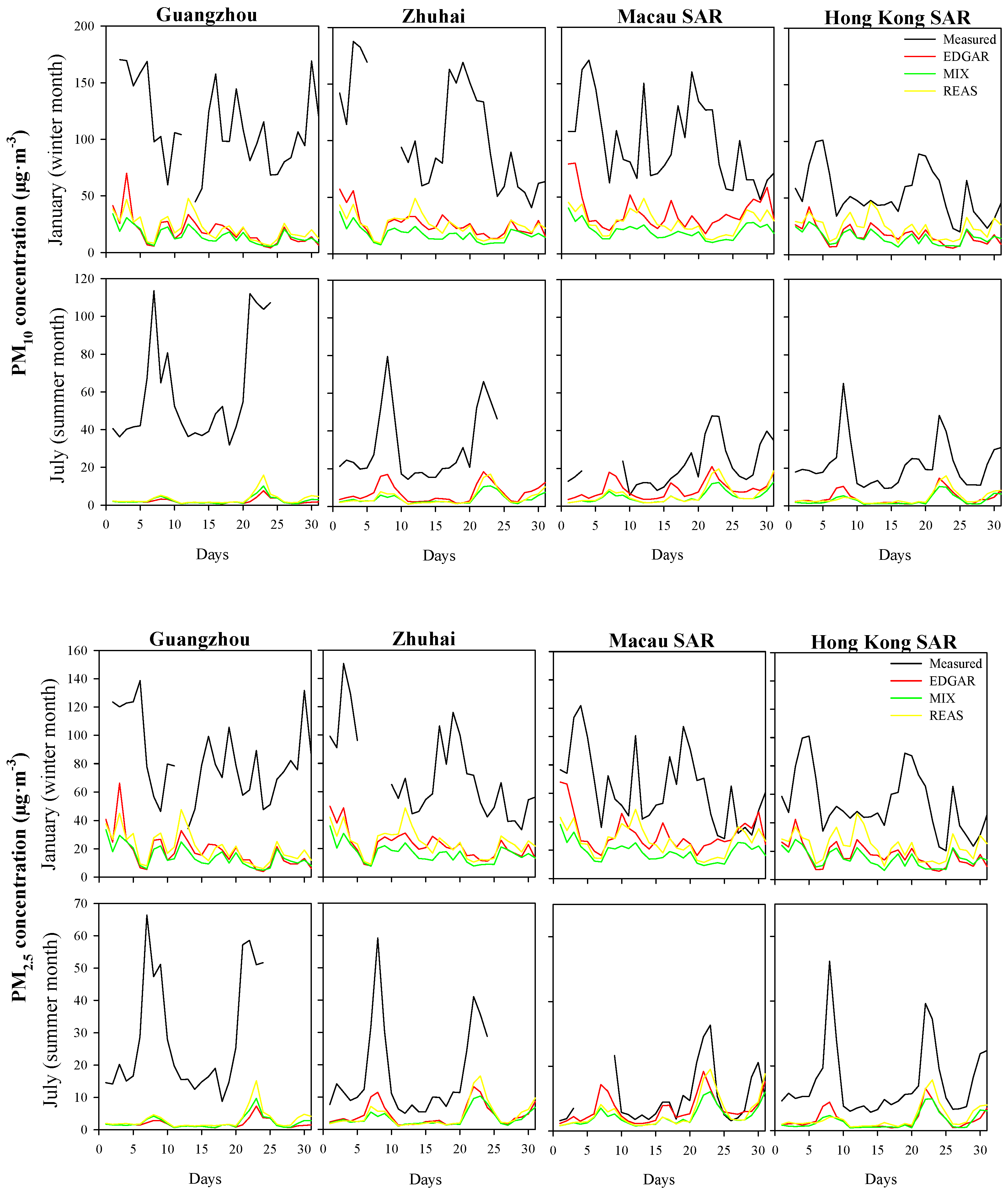
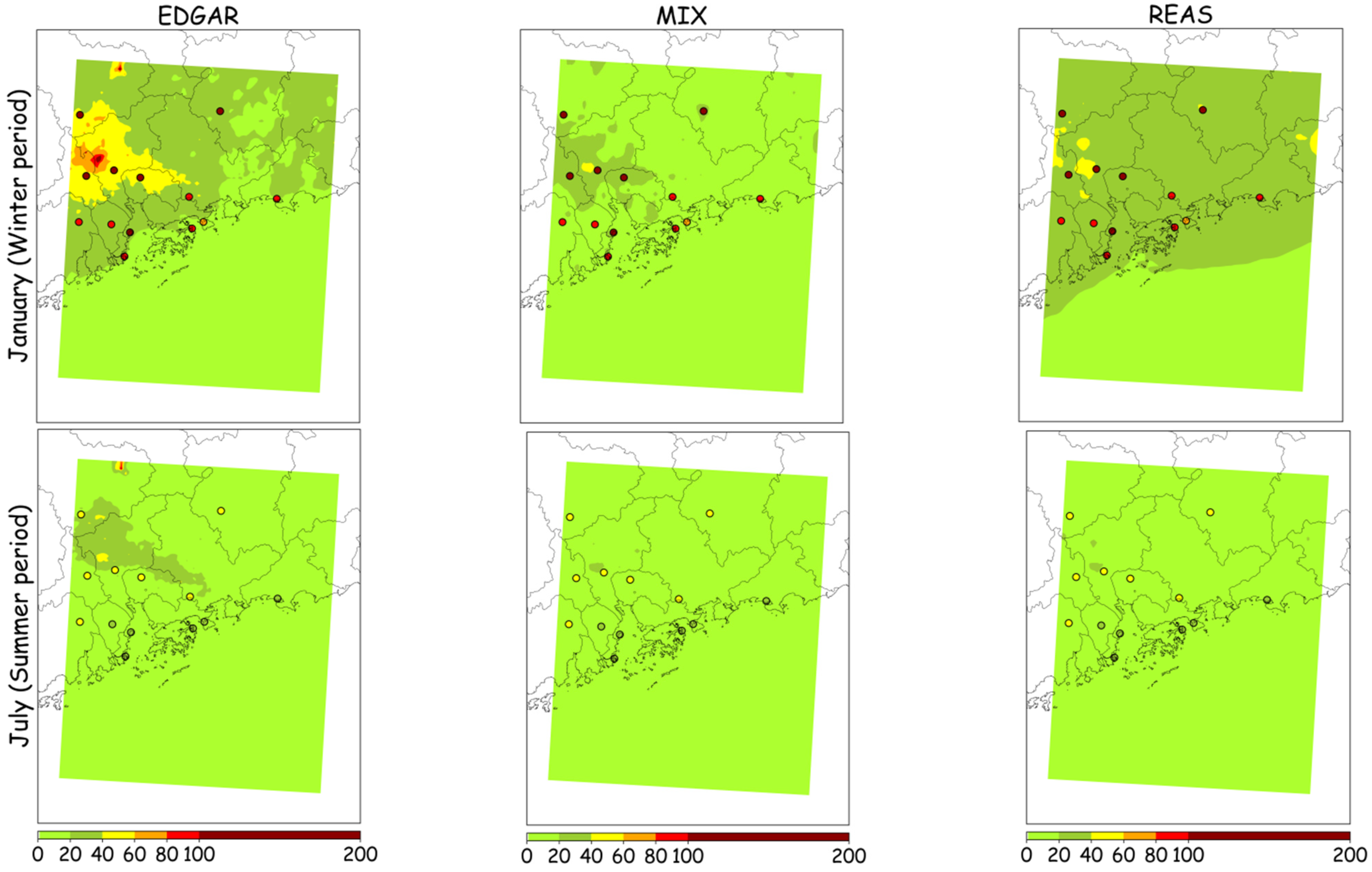


Publisher’s Note: MDPI stays neutral with regard to jurisdictional claims in published maps and institutional affiliations. |
© 2021 by the authors. Licensee MDPI, Basel, Switzerland. This article is an open access article distributed under the terms and conditions of the Creative Commons Attribution (CC BY) license (https://creativecommons.org/licenses/by/4.0/).
Share and Cite
Lopes, D.; Ferreira, J.; Hoi, K.I.; Yuen, K.-V.; Mok, K.M.; Miranda, A.I. Emission Inventories and Particulate Matter Air Quality Modeling over the Pearl River Delta Region. Int. J. Environ. Res. Public Health 2021, 18, 4155. https://doi.org/10.3390/ijerph18084155
Lopes D, Ferreira J, Hoi KI, Yuen K-V, Mok KM, Miranda AI. Emission Inventories and Particulate Matter Air Quality Modeling over the Pearl River Delta Region. International Journal of Environmental Research and Public Health. 2021; 18(8):4155. https://doi.org/10.3390/ijerph18084155
Chicago/Turabian StyleLopes, Diogo, Joana Ferreira, Ka In Hoi, Ka-Veng Yuen, Kai Meng Mok, and Ana I. Miranda. 2021. "Emission Inventories and Particulate Matter Air Quality Modeling over the Pearl River Delta Region" International Journal of Environmental Research and Public Health 18, no. 8: 4155. https://doi.org/10.3390/ijerph18084155
APA StyleLopes, D., Ferreira, J., Hoi, K. I., Yuen, K.-V., Mok, K. M., & Miranda, A. I. (2021). Emission Inventories and Particulate Matter Air Quality Modeling over the Pearl River Delta Region. International Journal of Environmental Research and Public Health, 18(8), 4155. https://doi.org/10.3390/ijerph18084155








